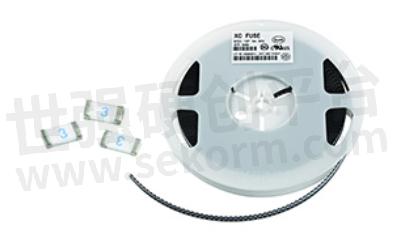Supplementary knowledge on purchasing chip type fuses




Fuses (patch type fuses), also known as fuses, as the name suggests, are used to protect circuit components. When the current eXCeeds the specified range of the electrical appliance, the fuse will heat up and blow, thereby achieving the purpose of cutting off the current and protecting the electrical appliance.
Supplementary knowledge on purchasing chip type fuses:
1. The working current of the selected chip type fuse should not exceed 75% of the rated current of the fuse.
2. The impact resistance of patch fuses is much smaller, so when purchasing patch fuses, special attention should be paid to pulse, impulse current, surge current, starting current, and circuit transient values.
3. Confirm the size of the circuit overload current that the patch fuse needs to pass through and the minimum and maximum duration of the overload current.
4. Another characteristic of patch type fuses is that installing fuses with excessive internal resistance in certain circuits, can affect the system parameters of the circuit and prevent it from working properly.
5. When the protective patch type fuse is applied to portable devices, the working voltage of the circuit is generally not high, but the temperature rise of the fuse should be appropriately considered because it is sensitive to changes in environmental temperature. The normal working current rating of the fuse is usually reduced by 25% to avoid harmful blowing; The voltage rating must be equal to or greater than the effective circuit voltage, and the standard voltage rating series are 24V, 32V, 48V, 63V, 125V.
Generally, the maximum current during normal operation of the circuit should be calculated based on the total power of the electrical appliances connected to the circuit, and then a fuse should be selected so that its rated current is equal to or slightly greater than the maximum current during normal operation of the circuit. For appliances with electric motors such as washing machines and refrigerators, because the current when the motor starts is much higher than during normal operation, the rated current of the fuse is generally chosen to be three times the normal working current of the motor. In practical applications, if there is only a thin fuse that does not meet the specifications, two or more strands can also be used in parallel as needed. However, it is not allowed to blindly increase the capacity of the fuse by arbitrarily thickening it, and other metal wires such as thick copper wire, iron wire, or aluminum wire cannot be used to replace the fuse. After the fuse burns out, the power should be disconnected first to check the circuit, eliminate the fault, and then replace the appropriate fuse.

Fig.1
- +1 Like
- Add to Favorites
This document is provided by Sekorm Platform for VIP exclusive service. The copyright is owned by Sekorm. Without authorization, any medias, websites or individual are not allowed to reprint. When authorizing the reprint, the link of www.sekorm.com must be indicated.
Recommend
The Operating Principle of Tubular Fuses
2023-12-31 - Design Article Why sometimes patch type fuses become highly resistant and we know that the operating principle of tubular fuses is: overcurrent causes the thermal balance on the melt to be disrupted, and when the melt temperature rises to the melting point of the metal material, the middle part of the melt changes from solid to liquid. Due to the surface tension and gravity of the metal material suspended in the tube, the liquid part of the melt pulls away from both ends and drops downwards, The flashover caused by voltage causes the melt temperature to continue to rise.
How Many Types of Fuses are There?
2023-12-28 - Design Article Below is an introduction to the classification by type, which can be divided into current fuses: patch fuses, miniature fuses, plug-in fuses, and tubular fuses; Temperature fuse: RH square type, RP resistance type, RY metal case; Self recovery fuse: plug-in, laminated, patch.
How to Select Low Voltage Fuses with Chip Mounts
2023-11-29 - Design Article Chip low-voltage fuse is a type of fuse, abbreviated as chip low-voltage fuse. The function of a low-voltage fuse is to provide short circuit protection in the circuit. Its advantages include high breaking capacity, strong reliability, small installation area, convenient maintenance, and low price. The disadvantage is that there are few protection methods and the recovery time of power supply is long. Baodian Tong‘s main chip fuse.
Small fuses Transmit Positive Energy
2024-01-12 - Manufacturer News In daily life, the application of fuses is very extensive, and the accompanying safety issues are also very many. Although fuses are small, they can also transmit positive energy.
Temperature Characteristics of Current Fuses
2024-11-16 - Technical Discussion Current fuses exhibit specific temperature characteristics that play a crucial role in their performance and reliability. The behavior of a current fuse in response to temperature changes is determined by several factors.
Selection of Current Fuses in Automotive Circuits
2024-11-16 - Technical Discussion In automotive circuits, the selection of current fuses is of great significance for ensuring the safe operation of the vehicle. There are several key factors to consider when choosing a current fuse for an automotive circuit.
Why are Domestic Fuses Cheap?
2024-01-07 - Design Article When choosing fuses, although they are of the same type, there are still differences. For example, the prices, quality, and parameters of fuses produced by domestic, foreign, and different fuse manufacturers may vary. Especially in terms of price, domestic fuses are cheaper than foreign ones. Why is this? There are also reasons from the fuse manufacturer.
Classification of Fuses
2023-11-30 - Technical Discussion Fuses are divided into two categories: high voltage and low voltage. High voltage fuses for 3kV-35kV; Low voltage fuses are used for AC 220V, 380V, and DC 220V, 440V.
Encapsulation Forms of Current Fuses
2024-11-13 - Technical Discussion The encapsulation of current fuses is an important aspect that affects their performance, durability, and safety.
How to Choose Fuses for Blockage Experiments
2024-09-13 - Technical Discussion This article introduces How to choose fuses for blockage experiments.Ensure that the selected fuses comply with relevant certification and standard requirements, such as UL, CE, etc. This can ensure the quality and safety of the fuse.
What Is The Difference between Resettable Fuses and Traditional Fuses?
2024-09-04 - Technical Discussion PPTC and fuses both do the same job: protecting electronic circuits from overcurrent related issues. The difference is that the fuse must be replaced after tripping, while PPTC can reset itself. PPTC can handle sudden overcurrent events without the need for replacement.
The Role of Current Fuses in Smart Meters
2024-11-08 - Technical Discussion Current fuses play a vital role in smart meters. Firstly, they provide protection against overcurrent events. Smart meters are used to measure and manage electricity consumption accurately. However, electrical circuits can sometimes experience sudden surges in current due to various reasons such as power outages and subsequent restoration, short circuits in the electrical grid, or the malfunction of connected electrical appliances.
How to Understand the Holding Current and Triggering Current of Fuses
2023-12-20 - Design Article A netizen left a message asking: How do you understand the difference between maintaining the current and triggering the current of a fuse? Fuses all have a holding current and a triggering current. Below, the XC FUSE will analyze the difference between the holding current and the triggering current of fuses.
What Do You Need to Know about Automotive Fuses
2024-01-25 - Design Article For automotive fuses, let‘s first understand: fuses are common names, their scientific name is fuse, but we usually refer to them as fuses. Their basic function is to protect the circuit when overcurrent occurs.Generally speaking, fuses mainly have two important parameters: rated current and rated voltage. We usually choose the corresponding specifications of fuses based on the current and voltage of the circuit. Automotive fuses generally adopt a plug-in design, with a plastic outer shell wrapped in a molten structure made of zinc or copper, and a metal melt connected to the pins.
Several Factors Influence the Lifetime of Current Fuses
2024-11-06 - Technical Discussion The lifetime of a current fuse is influenced by several factors. Firstly, the current rating of the fuse plays a crucial role. If a fuse is constantly operating near or at its rated current, it will experience more heat buildup and stress over time, which can shorten its lifetime.
Electronic Mall
Integrated Circuits
Discrete Components
Connectors & Structural Components
Assembly UnitModules & Accessories
Power Supplies & Power Modules
Electronic Materials
Instrumentation & Test Kit
Electrical Tools & Materials
Mechatronics
Processing & Customization
























































































































































































































































































































































































































































































































































































































































































































































































































































































































































































